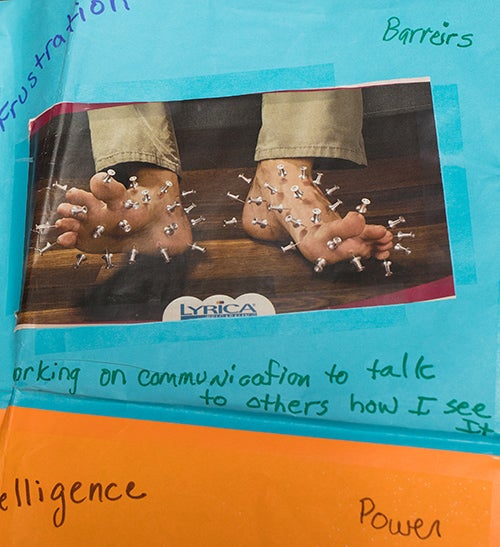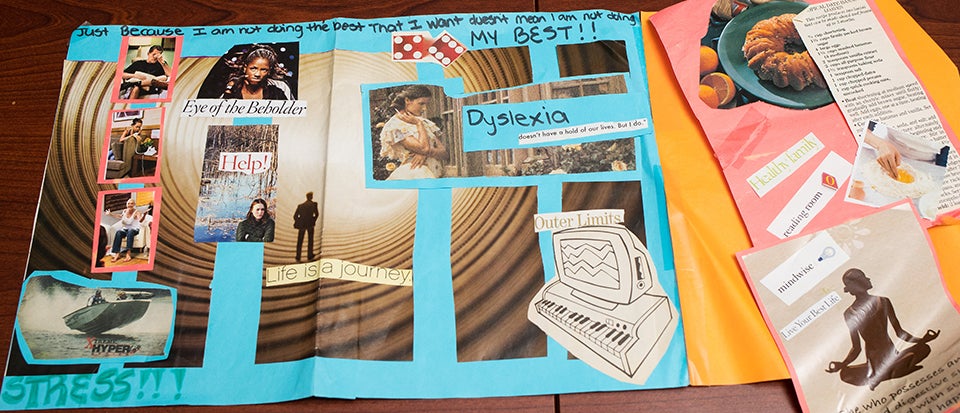LEARNING ABILITY
Project focuses on dyslexia and differences in learning
Two researchers in East Carolina University’s School of Social Work will soon start a new phase of a decade-long project examining how people live with dyslexia.
The goal of Lena Carawan and Blace Nalavany’s work is to raise awareness and understanding about dyslexia while informing clinical and public policy decisions.
“Lots of people refer to it as a learning disability. We try to leave that ‘dis’ out,” Carawan said. “Everybody learns differently.”
According to the National Institute of Neurological Disorders and Stroke, dyslexia is a brain-based type of learning disability that specifically impairs a person’s ability to read. While it varies from person to person, it’s characterized by difficulty with language, spelling, short-term memory and organizational skills.
“Dyslexia doesn’t end in childhood,” Nalavany said. “It’s a lifelong difference.”
People with dyslexia often are creative and think “outside the box” to compensate for their left-brain challenges, Carawan said. “They see the big picture,” she said. “They problem-solve differently because they learn differently.”
Approximately 12 percent of the U.S. population has dyslexia, which is believed to be a conservative estimate, according to research by Dr. Sally Shaywitz, director of The Yale Center for Dyslexia and Creativity.
Carawan and Nalavany’s research is unique because they have focused on what it’s like to live every day with dyslexia – the psychosocial and emotional aspects – rather than the neurology behind the condition.
“This is a hidden difference for many people and misunderstood by the public at large,” Carawan said.
In January, Carawan and Nalavany and two ECU graduate research assistants, Hailey Harris and Nicole Deen, will begin a new phase of study by recruiting parents with dyslexia who have children with dyslexia.

Associate professors Blace Nalavany and Lena Carawan hope to inform clinical and public policy decisions and heighten awareness and understanding of dyslexia. Here, a research participant uses art to describe what it’s like to have dyslexia.
Approximately 30 percent to 66 percent of children with dyslexia have a parent with dyslexia, according to recent data. “I can’t tell you how many people learn they have it when they have their children tested,” Carawan said.
Carawan and Nalavany already have interviewed 20 parents with dyslexia in the current phase but want to reach more. While the public school system can make a huge difference for some students, parents sacrifice a great deal – sometimes mortgaging their homes – to ensure their children with dyslexia are educated in specialty or private schools to maximize potential when possible.
“I’m reliving what I went through,” participants with children with dyslexia have told Carawan and Nalavany. “I don’t want them to experience what I did in school.”
Carawan and Nalavany have a personal connection to dyslexia, which runs in both their families. “We’re familiar with the challenges it presents,” he said. “Clinically I’ve worked with children and adults with dyslexia and other learning differences.”
A former school social worker, Carawan worked with children with learning differences. “It evolved from there,” Carawan said. “My son and brother have dyslexia. We can track it for three generations in our family.”
At ECU’s College of Health and Human Performance, Carawan and Nalavany have held focus groups and worked with STEPP, a program on campus that partners with students with learning disabilities.
They have presented nationally and internationally on their research, which included an online survey of 225 people that asked up to 200 questions to better understand dyslexia.
They also have compiled comments, photography and artwork created by people who have dyslexia to help teach others about its impact.
“Dyslexia is a lifelong issue,” said one participant. “Even though I am successful, I constantly live with the fear of failure.”
“We want their voices to be heard,” Carawan said. “We want the public to understand who a person is with dyslexia. They should not be discounted. They have a lot to offer.”
For more information on the research at ECU, visit
http://www.successwithdyslexia.com/Dyslexianews.html.
Another website, http://data.qz.com/2016/dyslexia/, helps people without dyslexia see how dyslexia looks to someone while reading.

Associate professors Blace Nalavany and Lena Carawan asked research participants to make collages to describe what it’s like to live with dyslexia, which affects (conservatively) an estimated 12 percent of the U.S. population.